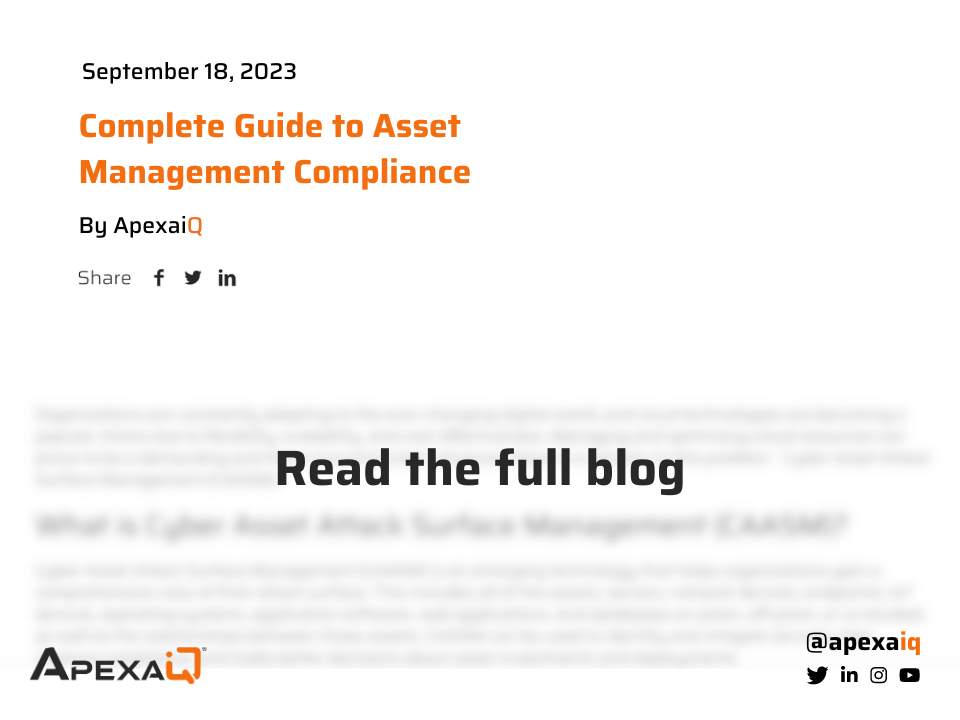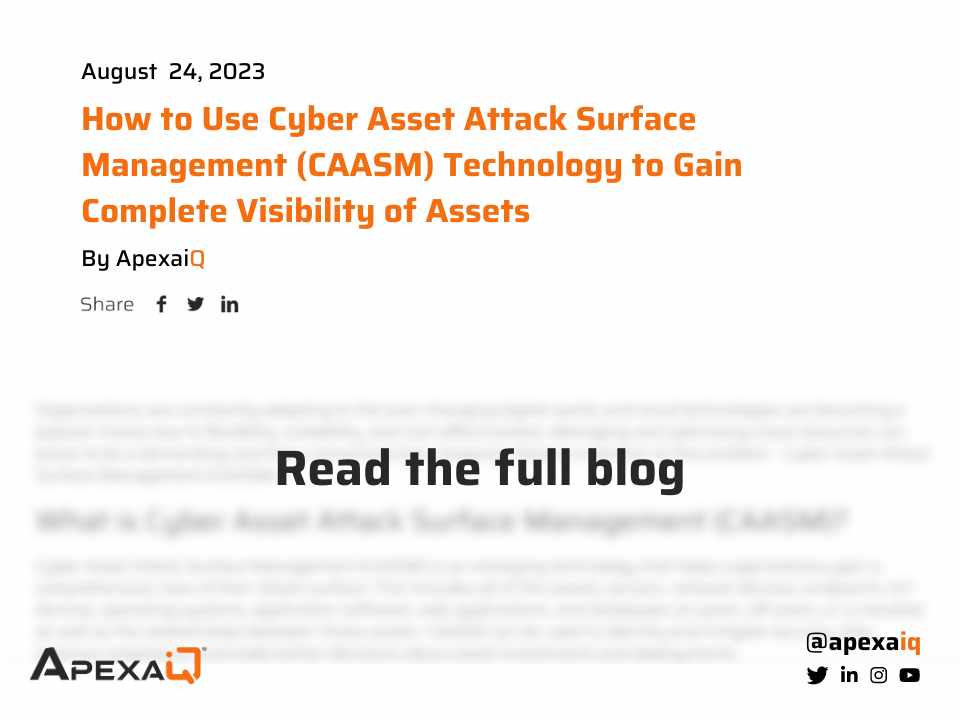
December 21, 2022
How to Increase Business Value with IT Asset Management (ITAM)
By Apexa iQ
As organizations experience an increase in IT assets over time, IT professionals are looking to get a better understanding of how to easily keep track of their IT assets effectively and efficiently.
Many organizations don’t have the time, money, or resources to keep track of their assets effectively. IT teams need, and should have, immediate access to detailed information about their internal IT. This is where IT Asset Management (or ITAM) comes in.
What is ITAM?
IT Asset Management (ITAM) is the process of ensuring an organization’s (usually a business) IT assets such as hardware, software, SaaS based products, etc. are accounted for. This process seeks to maximize the value of IT assets and equipment within an organization by combining financial, contractual, and inventory data to track the status of IT assets across their lifecycle.
Assets have a limited amount of time for use, and an organization can maximize their value with ITAM and proactive management. An IT Asset Management solution accounts for making sure that the valuable IT assets in your organization are being tracked for and used as well as tracking the maintenance, obsolescence, and compliance of your IT assets. Put simply, it's making sure that the valuable items, tangible and intangible, in your organization are tracked and being used.
Benefits of an IT Asset Management Solution
There are many benefits that an ITAM solution can deliver for your organization, but the most critical benefits are that ITAM can help keep your organization secure, compliant, and truthful. However, ITAM does far more. Here are 6 benefits of IT Asset Management you probably didn’t know about.
- Benefit 1: gain visibility and accuracy of your IT assets in a single source of truth on a single dashboard, in real-time.
- Benefit 2: eliminates the need for paperwork and spreadsheets by tracking your assets in the cloud.
- Benefit 3: improves utilization, reduces risk, and helps to eliminate “dirty” data such as forgotten, duplicate, or outdated data.
- Benefit 4: reduces IT costs by regularly reviewing your IT assets and can recognize when a hardware refresh is needed, which users need certain licenses, and flagging underutilized assets.
- Benefit 5: helps to keep your IT infrastructure modern with the ever-changing technology that is hard to keep up with.
- Benefit 6: remain compliant with ITAM and rest assured that the terms of your software contract aren’t being violated (against the terms of your agreement, using too many users, etc.).
What are the types of IT Asset Management?
Now that we have talked about what ITAM is and how it can increase the business value for your organization, let’s talk about the types of IT Asset Management.
ITAM focused on Software
Software assets are typically licensed by the organization such as compliance, licensing, shadow IT, and IoT. IT asset management processes for software allow organizations to monitor their compliance status with the end user licensing agreements that allow them to use licensed software applications.
These types of assets must always be monitored and reviewed. Your organization can monitor the status of the software and plan accordingly for future costs, as well as monitor how many licenses are in use to ensure you're getting the most value for each software license that you pay for.
ITAM focused on Hardware
Hardware, also referred to as physical assets, include:
- PC's
- Printers
- Copiers
- Laptops
- Mobile Devices
- Servers
- Any other hardware that is used for data management purposes within the company
Managing your organization’s hardware involves making decisions about what kind of devices a company requires to power its IT systems. Asset management for such physical devices often includes determining if devices are compatible with the company’s software, placing orders for more equipment, and sourcing the physical location of the devices.
ITAM focused on Cloud
Many companies will use the cloud to store data instead of hosting internal databases. With that, some people may think that putting assets in the clouds means “set it and forget it”. However, that is not the case. Cloud asset management is an integral part of business operations. It provides you a centralized location, easy access, scalability, and time savings when searching for your assets.
Cloud based assets you can manage include
- SaaS
- PaaS
- Web storage
- Online servers
- Meta data
- Security and compliance
- Email servers
- Phone
- Etc...
IT Asset Management Lifecycle
The IT asset management process usually follows a formalized process. Although, some organizations may have their own IT asset lifecycle, most follow the same basic 6 step lifecycle:

Request
The first step in the ITAM Lifecycle takes place before any assets are purchased or deployed, also known as the “planning” phase. This is where stakeholders get together and discuss what assets are needed, how to obtain them, and how they’ll be used and funded. There is then a formal request for an IT asset.
Fulfillment
Once the request has been made, it must pass through different levels of approval. This includes comparing in-stock assets to see if any are capable of fulfilling the request and if not, the asset must be purchased or leased. Fulfillment also includes the licensing of assets.
Deployment
Once the right IT assets are available, they will be deployed into service. During deployment, the employee oversees the installation of the assets into the IT ecosystem allowing organizations to automatically provide applications, cloud resources, hardware, etc.
Monitoring
Monitoring your IT assets is crucial. This stage in the lifecycle Is focused on increasing visibility in your IT Environment, optimizing asset usage, and identifying and mitigating vulnerabilities.
Maintenance
Just like a car, after so many “miles” (uses), the asset will require carious forms of service to maintain its functionality. In this step, the assets are maintained and upgraded/repaired to prolong asset longevity. Regularly scheduled maintenance is highly recommended.
Retirement
The last stage of the ITAM lifecycle is retirement. One an asset reaches end-of-life, meaning the manufacturer will no longer update and or provide maintenance to the asset, it is time to dispose of and replace the asset. Disposing of old assets can help keep your company secure and compliant.
How Apexa iQ’s ITAM Can Increase Business Value and Improve Compliance
Now that we know all about ITAM, we can ask ourselves how does ITAM increase business value? How does it help my company stay compliant?
ITAM is about more than creating an asset inventory. The Apexa iQ platform delivers real-time, accurate asset inventory across hardware, software, and SaaS based assets. Being able to see your entire IT estate can help increase business value by avoiding unnecessary asset purchases and refreshes while making the best use of current resources.
- Avoid manual, error-prone data entry and inventory: With ApexaiQ, you can automate your IT environment, determine obsolescence, ensure compliance, make lifecycle improvements, reduce technical debt, and improve security postures all within one platform. The platform can streamline and automate an accurate CMDB for you to eliminate manual inventorying.
- Cut costs: Accurate inventory of your internal assets can help to decrease spending on refreshes and new assets that are not needed.
- Boost operational efficiency: in addition to automated inventorying, you can create reports and queries to stay one step ahead of your assets becoming non-compliant and end-of-life.
- Ensure compliance: ISO (International Standards Organization) established an official set of standards for ITAM. The Apexa iQ dashboard tells you when an asset becomes non-compliant. The ISO standards include:
- ISO/IEC 19770-1: Outlines the framework and best practices for ITAM within a company.
- ISO/IEC 19770-2: Establishes specifications for tagging software to optimize its identification and management.
- ISO/IEC 19770-3: Details the entitlements associated with a piece of software and the method for measuring consumption.
- ISO/IEC 19770-4: Allows for standardized reporting of resource use. This is particularly important when managing more-complex licenses and cloud-based software and hardware.
- ISO/IEC 19770-5: An overview of ISO ITAM standards and vocabulary.
- Smart decision making: With an increased visibility of your digital assets, you and your company have a better understanding for strategic decision-making when it comes to your infrastructure.
IT asset managers can cut software licensing and support costs, eliminate waste, and improve efficiencies with ITAM.
Responsibilities of IT Asset Managers
Knowing what we know about IT Asset Management, there needs to be someone who is responsible for managing the assets.
The role of an IT asset manager may seem obvious, but here is a list of what it takes to be a successful manager.
Set and communicate policies
Communicate clearly and effectively what an asset is and any asset purchasing policies to your team. Communicate the value of these policies in the language of each business unit, and you may just find champions sprouting up across the company.
Coordinate governance, processes, and reporting
Now that policies are in place, it is time to ensure they are enforced. Creating standard processes and guidelines around these policies will allow all to follow when purchasing assets. These policies and guidelines are also important for when someone new comes on board.
Another key responsibility is being able to identify, in real-time, who owns assets, who uses them, how frequently they are being used, which features are being used, etc. Reporting matters!
Identify, assess, and quantify risk
In order to measure risk of your IT estate, you need to know what assets you have. Identifying your assets with an IT Asset Management platform like Apexa iQ will allow you to see into your entire IT estate in minutes. Obtain reporting and next steps on what risks and vulnerabilities may have in your IT estate.
Once identified, ask yourself: How likely are these risks? What are the biggest priorities when it comes to risk? How much will these vulnerabilities impact the business?
Facilitate and track remediation
It's not if, but when. Decreasing your exposure to vulnerabilities is crucial; having an accurate, up-to-date inventory will help mitigate that. As an IT manager, it is not only your job to set policies and re-enforce them but also to put the puzzle back together if something doesn’t go as planned.
Assign assets and the responsibility for managing them
Delegating is an important part about being a manager. Some assets may only be used by one team or used cross-functionally, so it makes sense to assign those assets to someone who can monitor those assets more closely. This person will need to make decisions based on the data that is reported on for usage, any vulnerabilities that are seen, etc., and come up with the best course of action.
Provide evidence of compliance
Now that everything is in place, leadership and even board members will want proof that you have the assets under control. Leaders will want to understand if there is a need to spend on refreshes, if there are any vulnerabilities that are present, what kinds of data you are housing and if the assets are compliant or not. Reports will become your best friend! But not in spreadsheets, thankfully. IT asset management platforms allow you to view this information in a single-dashboard and makes it easy to report and display.
Why you need ITAM
IT Asset Management is the key to your organizations cybersecurity stack as it can help save your organization from attacks on vulnerable assets. ITAM helps to mitigate risk, ensure patches are being deployed, locates any forgotten assets, and helps to improve reporting accuracy for business leaders.
ITAM is significant to any organization. It discovers your entire IT estate and delivers a report on your IT assets (hardware, software, and SaaS based), vulnerabilities, obsolescence, compliance, risk reports, and more. Complete visibility into your entire IT estate results in increased efficiency, reduction is risk and costs, and overall improved effectiveness for your organization.


